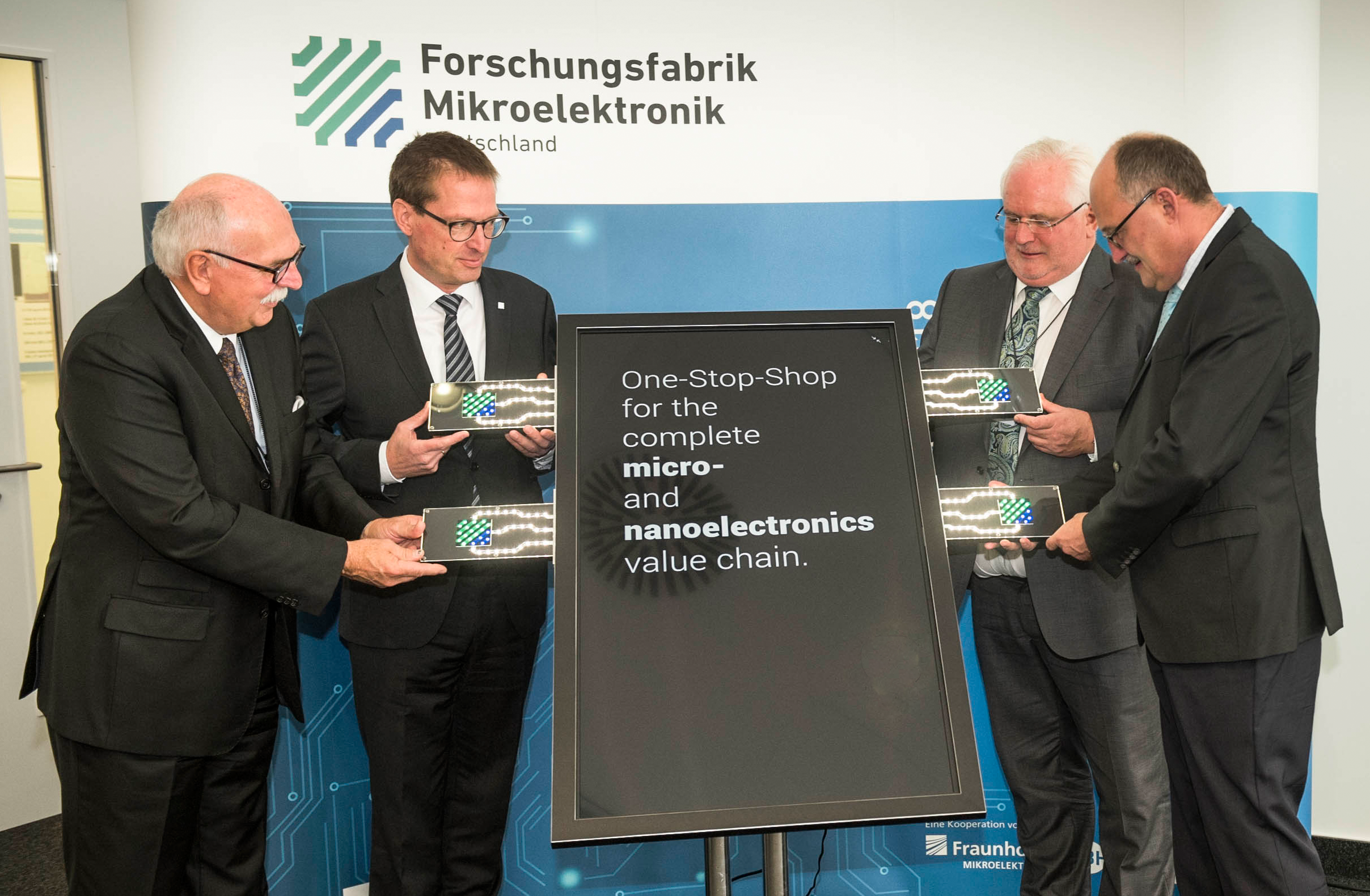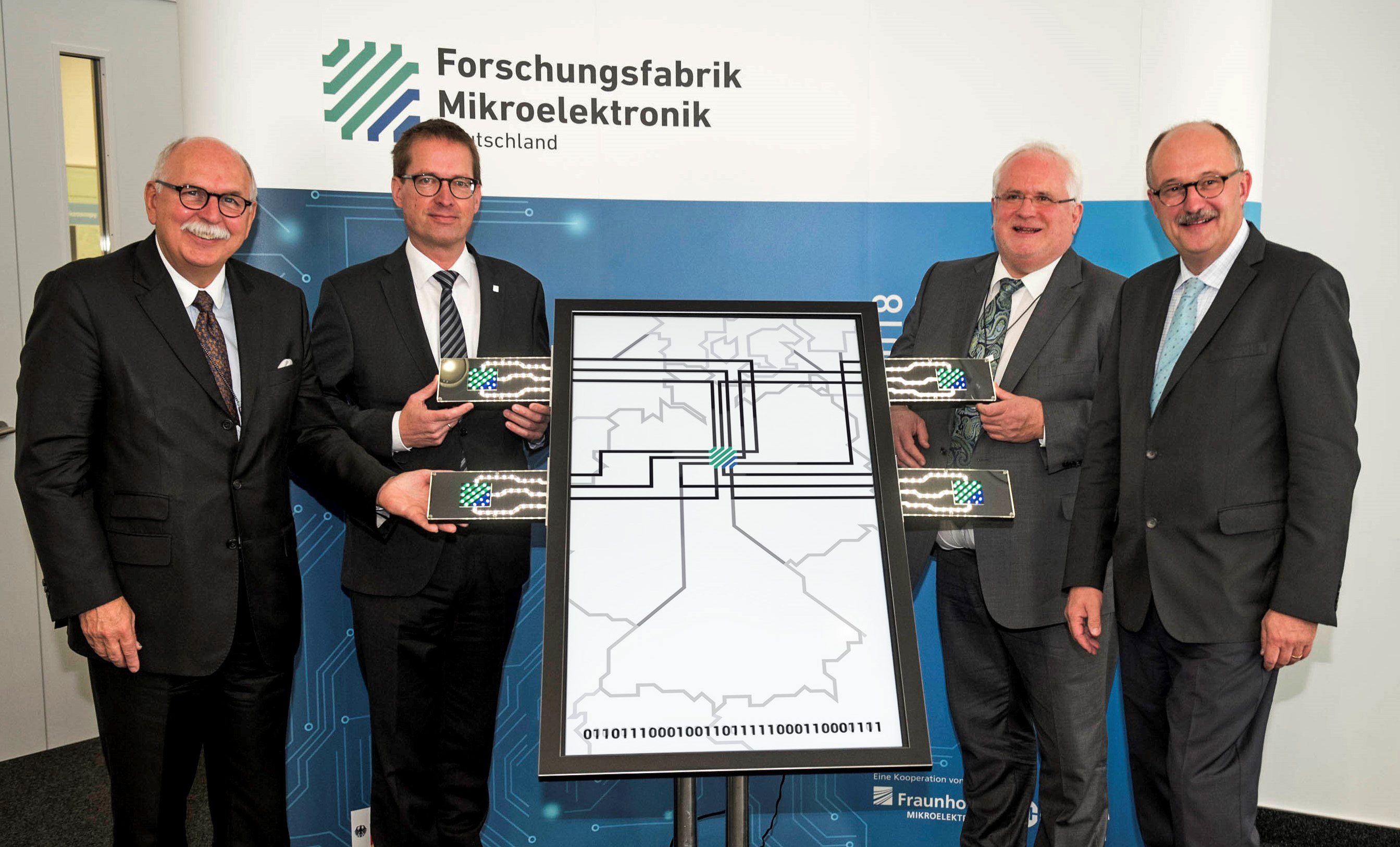Largest Microelectronics Research Cooperation in Europe Launches First Plants
The Research Fab Microelectronics Germany (FMD) collaboration promises easier access to future developments and nationwide coordinated technology know-how from a single source. A year and a half after the project started, the cooperation partners and their funding associates at the German Federal Ministry of Education and Research (BMBF) inducted the new research equipment with a ceremonial celebration held at the first FMD Innovation Day on the premises of the Fraunhofer Institute for Reliability and Microintegration (IZM) in Berlin.


In recent months, the members of the Research Fab Microelectronics Germany - made up of eleven Institutes of the Fraunhofer Group for Microelectronics and the Leibniz Institutes FBH and IHP - have been intensively involved in expanding the cross-location network. Now, the first equipment for the modernization of the laboratory facilities purchased from the 350 million Euro BMBF funding is going into operation as represented by the commissioning of the first integration line at the Fraunhofer IZM in Berlin on 28th September 2018. Hosts included BMBF Parliamentary State Secretary Dr. Michael Meister, Leibniz Association President Prof. Matthias Kleiner, Fraunhofer-Gesellschaft Board Member Prof. Georg Rosenfeld, as well as FMD Steering Committee Chairman and Fraunhofer IPMS Executive Director Prof. Hubert Lakner. More than 130 guests had the opportunity to visit the Fraunhofer IZM cleanroom facilities during the first FMD Innovation Day event. Films depicting the current state of modernization progress at all 13 member institutes were shown to demonstrate the merger of micro- and nanoelectronics research across the nation.
An Important Step for Innovation from Germany
The German and European semiconductor and electronics industry have been provided a unique opportunity with the establishment of the Research Fab Microelectronics Germany (FMD). Parliamentary State Secretary of the Federal Ministry of Education and Research (BMBF) Dr. Meister, M.D. underscored the potential of this unprecedented cooperation in microelectronics research saying, “In the digitization age, we again need more high-tech growth in Europe. Because we want to play a decisive role in shaping the future and develop the microelectronics of the day after tomorrow, we are combining state-of-the-art equipment with a new form of nationwide collaboration for the first time through the Research Fab Microelectronics Germany (FMD) project. We are providing our industrial research partners, particularly small and medium-sized enterprises, with an internationally competitive and decentralized research opportunity. In doing so, we are expanding Germany as center of innovation – keeping an eye on Europe, economic growth, and jobs as well as on the benefits to our private and professional daily lives.”
During his welcome speech, Leibniz Association President Prof. Matthias Kleiner was convinced that “Cooperations such as the Research Fab Microelectronics Germany and a strong interdependency of scientific results and their economic application are the keys to successful innovation. The Research Fab is particularly promising because it quite naturally unites what was, for a long time and sometimes still, thought of separately: research and application, research and processing, research and production.”
Prof. Georg Rosenfeld, Executive Vice President Technology Marketing and Business Models of the Fraunhofer-Gesellschaft, also looked optimistically into the future stating, “With the investments that have been made, we are able to offer solutions with a high degree of technical maturity for a broad range of industries along the entire innovation chain – for large, medium-sized and small companies as well as start-ups.”
Chairman of the FMD Steering Committee and Fraunhofer IPMS Executive Director Prof. Hubert Lakner added, “It is particularly important to shape entry barriers in a manner that new and young companies have easier access to these high technologies. We plan to build a consistent technological basis for that purpose over the next five to ten years.”
Development from First Draft to Finished System
On the first day of this year's FMD Innovation Day event, participants were provided the opportunity to get information on the latest FMD technical contributions in lecture sessions on self-sufficient microsystems, LiDAR, and Industry 4.0. They were also able to exchange their views with experts and users. In the framework of the complementary “Smart Micro Systems” trade fair, member institutes displayed technological know-how with visual highlights and live demonstrators such as the compact LiDAR camera for fast and reliable distance measurement, and the ball screw drive for process-controlled condition monitoring of, until now, difficult-to-reach or inaccessible positions of machinery and equipment. Guests to the trade fair were able to view complete prototypes.
More Power for German Microelectronics Research
With more than 2,000 scientific staff, the Research Fab Microelectronics Germany (FMD) is already the world's largest pool of technologies in the field of smart systems. Cross-location collaboration focuses on future-relevant topic areas including the newest silicon technologies for sensor and information processing, semiconductors with state-of-the-art materials used in communication technology and to save energy, novel combinations of silicon and other semiconductors for the Internet of Things, as well as for design, test and reliability of quality and safety.
In addition, the 13 partner institutes are exploring technological issues of the future. Important challenges include the industrial use of quantum technologies, the development and integration of atomic functional blocks, systems for the terahertz area, reducing the power requirements of electronic circuits, and the storage and transmission of the largest of data amounts (petabytes). Economically important application areas include energy technology, transport and mobility, digital life, industrial manufacturing, and health and safety.
Last modified:
 Fraunhofer Group for Microelectronics in cooperation with the Leibniz institutes IHP and FBH
Fraunhofer Group for Microelectronics in cooperation with the Leibniz institutes IHP and FBH